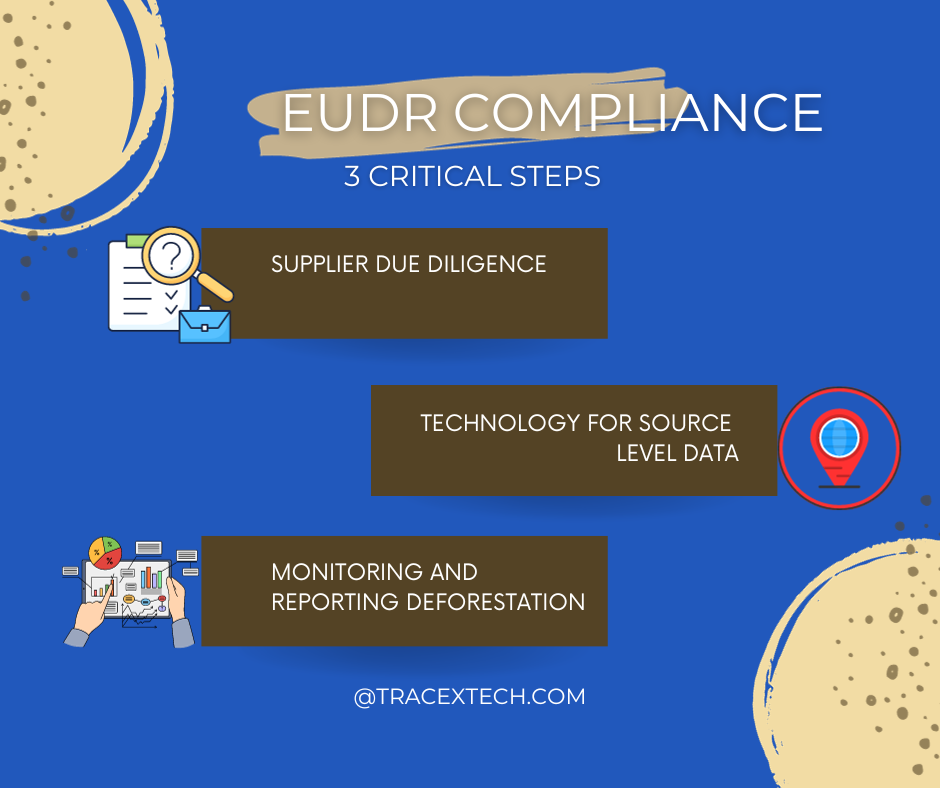Contact: +91 99725 24322 |
Menu
Menu
Quick summary: Discover a comprehensive 5-step traceability solution designed to ensure EUDR (European Union Data Rights) compliance. Unveil the key to navigating the regulatory landscape in our latest blog.

In an era of growing environmental consciousness, traceability solutions for European Union Deforestation Regulation (EUDR) stands as a powerful initiative aimed at curbing deforestation and its disastrous consequences on our planet. But how can businesses navigate this complex regulatory landscape, ensuring that the products they import are deforestation-free?
The clock is ticking for compliance with the EU Deforestation Regulation
Enter traceability, the unsung hero in EUDR compliance. This blog will unravel the vital role of traceability in helping businesses meet the EUDR’s stringent requirements, offering an exciting glimpse into the world of sustainable and transparent supply chains. Get ready to explore how traceability empowers companies to make a meaningful impact and contribute to a greener, more sustainable future.
Deforestation stands as a monumental environmental challenge of our times, posing a grave risk to the world’s ecosystems and climate. The European Union (EU) has embarked on a proactive journey to combat the expanding issue of deforestation. Among these efforts lies the EU’s regulatory framework for products free from deforestation, famously known as the European Union Deforestation Regulation (EUDR) compliance.
EUDR compliance serves as a comprehensive set of guidelines and standards, obliging companies to conform to stringent criteria to ensure that their products do not contribute to the detriment of forests. In this article, we will provide a comprehensive overview of EUDR compliance and investigate how cutting-edge technology plays a pivotal role in the fight against deforestation, aiding companies in achieving compliance and preserving our planet’s precious forests.
The new EU Deforestation Regulation (EUDR) will come into force on the 29th of June 2023 and on the 30th of December 2024 businesses will have to comply with all the requirements of the regulation. This leaves only 18 months for operators and traders to set up sufficient due diligence systems to comply with the new rules that affect seven commodities: wood, soy, cattle, cocoa, coffee, palm oil and rubber.
EUDR compliance, effective since June 29, 2023, serves as a stringent regulation within the EU. Its primary goal is to halt the import and sale of products associated with deforestation. This proactive approach is designed to promote sustainability, curbing the adverse effects of deforestation on ecosystems, climate, and human rights. Companies are required to meet EUDR standards by December 2024. For companies seeking to operate within the EU, adherence to EUDR regulations is imperative. Compliance entails proving that your products are not linked to deforestation upon entering the EU market. Non-compliance can lead to penalties, reputational damage, and a potential decline in market presence.
Traceability refers to the ability to track and document the origins and movements of products or components throughout the supply chain. It involves recording detailed information about each stage of production, processing, and distribution.
Traceability is crucial as it offers transparency in the supply chain. It ensures that companies can account for the origin of their products, which is a fundamental requirement for EUDR compliance. This transparency is vital for preventing products associated with deforestation from entering the EU market.
Compliance Requirement: EUDR mandates that companies prove their products are not linked to deforestation.
While some companies have established visibility within the initial tiers of their supply chains, EUDR compliance necessitates extending this visibility down to the very source of your commodities, such as the farms or plantations. This means linking the deforestation-free verification of the land plots where your commodities originate to the source transactions, providing concrete proof of compliance. Opt for a blockchain-based traceability platform that excels in gathering primary data at the farm or plantation level, complete with geolocation details that can be seamlessly linked to your product and its transactions. This strategic choice empowers your company to amass trustworthy data associated with your end products, simplifies the compliance procedures, and guarantees accountability and transparency throughout your supply chain.
A robust traceability solution capable of withstanding audits should seamlessly preserve the product’s chain of custody, encompassing every stage from the plot of land to distribution. The process of tracking and tracing your product’s voyage from its origin creates a digitized audit trail, documenting events and transactions accurately, including its environmental impact. By safeguarding unaggregated source data associated with your end product, you can assert with confidence its deforestation-free status at the farm or plantation level. It is crucial to verify the chain of custody from source to shelf to ensure your compliant commodities are not mixed with non-compliant commodities. By doing so, your company can prove that your products are produced and sold in a way that is consistent with the EUDR regulations.
Relying solely on spot audits is no longer sufficient. To meet EUDR compliance and maintain an in-depth understanding of your supply chain operations, real-time tracking is imperative. Your traceability solution should be equipped to continuously gather data as materials and ingredients progress through your supply chain. This approach guarantees the accuracy of your data for auditing purposes. To achieve EUDR compliance, it’s crucial for your company to continuously monitor and report on its deforestation status. This entails gathering up-to-the-minute data on the environmental footprint of your production, starting from the source. You should also generate readily available reports for both internal and external audits. Maintaining vigilance and proactivity is paramount for ensuring the auditability and compliance of your supply chain.
To ensure your company attains audit-proof traceability, it’s vital to track both primary and secondary data. Primary data refers to information collected at the source level within your company, whereas secondary data is acquired from partners or aggregators. Numerous current traceability frameworks solely focus on tracking secondary data, which falls short in ensuring data integrity. Employing a traceability solution capable of accurately monitoring both primary and secondary data is a necessity to prevent unverifiable claims.
A successful EUDR compliance strategy hinges on seamless integration between your traceability solution and existing systems. Choose a traceability partner that prioritizes interoperability and integration to maximize the benefits of your compliance efforts.

By leveraging blockchain technology, Tracex enhances data security, integrity, and transparency while addressing these challenges. It facilitates efficient data exchange, reduces costs, streamlines complex supply chains, and ensures data accuracy, all critical elements for achieving EUDR compliance in an effective and sustainable manner.
In conclusion, the role of traceability in EUDR compliance cannot be overstated. It is the linchpin that holds together the EU’s efforts to combat deforestation, protect ecosystems, mitigate climate change, and safeguard human rights. Traceability, as facilitated by technology and innovative solutions like Tracex’s blockchain-based platform, empowers companies to ensure their products do not contribute to deforestation. This is achieved through a systematic process of data collection, risk assessment, and mitigation strategies. The EUDR compliance timeline is a countdown that urges businesses to adopt traceability as a means to secure their place in the EU market.
The journey towards EUDR compliance is not just about meeting regulatory requirements; it’s an opportunity for businesses to lead in the transition towards a more sustainable future. Embracing traceability represents a commitment to responsible sourcing, environmental conservation, and ethical business practices. It safeguards reputations, fosters transparency, and positions businesses as drivers of positive change in supply chains.
